Concealed-Fault Detection in Low-Amplitude Tectonic Area—An Example of Tight Sandstone Reservoirs
Abstract
:1. Introduction
2. Methods and Tests
2.1. Method
- (1)
- Calculate the multi-scale and multi-orientation log-Gabor filter bank in the frequency domain;
- (2)
- Calculate the Fourier transform of the coherence slice;
- (3)
- Convolve the results in step (2) with all multi-scale and multi-orientation filters, and calculate the Inverse Fourier transform;
- (4)
- Extract the total energy by summing the scale-dependent absolute amplitude obtained in step (3) in each orientation. Researchers can obtain the denominator in formula (1) in this step;
- (5)
- Follow step (3) to calculate the energies of even and odd versions, obtain their square root of amplitude, and count the weighted mean phase angles;
- (6)
- Compute the sigmoidal weighting function for each orientation;
- (7)
- Calculate numerator in formula (1);
- (8)
- Compute the PC for each orientation;
- (9)
- Extract some characteristics from the PC such as the feature phase and the maximum moment.
2.2. Tests
3. Application
3.1. Background
3.2. Problem
3.3. Result
4. Conclusions
- (1)
- The phase congruency method focuses more on the “location” of faults rather than the discontinuity values. For this reason, this method is equally sensitive to effective information and noise and should be combined with geological structures to eliminate unnecessary disturbances.
- (2)
- The study area mentioned in this paper is located in the low-amplitude structural area of the Ordos Basin in China, formed from the Late Jurassic to the end of the Early Cretaceous period and earlier than the main accumulation period of Mesozoic oil reservoirs. Hidden faults with small fault distances and small spatial extensions are difficult to detect with conventional methods. Using the phase congruency analysis method, we first helped geologists to demonstrate the existence of a shear fault zone in the northeast of the work area. This has a positive significance in terms of expanding the area of high-quality reservoirs to the north and east. Second, a new and vast fracture zone in the center of the survey, slightly to the south, was found. It is the stress relief area of different fault zones and likely has more crossed-fracture networks. This is a positive development in terms of providing the necessary oil or gas channels in tight sandstone reservoirs. Thirdly, a series of hidden faults in other strata were newly discovered. Some of these faults influence the bottom water, causing water to flow out during the process of testing for oil, which decreases the recovery rate; some faults form effective channels, improve the overall permeability of the reservoir, and contribute to accumulation. This research is of great significance for understanding the law of oil and gas migration and avoiding the risk of leakage caused by fracturing.
Author Contributions
Funding
Data Availability Statement
Acknowledgments
Conflicts of Interest
References
- Gersztenkorn, A.; Marfurt, K.J. Eigenstructure-based coherence computations as an aid to 3-D structural and stratigraphic mapping. Geophysics 1999, 64, 1468–1479. [Google Scholar] [CrossRef]
- Marfurt, K.J.; Sudhaker, V.; Gersztenkorn, A.; Crawford, K.D.; Nissen, S.E. Coherency calculations in the presence of structural dip. Geophysics 1999, 64, 104–111. [Google Scholar] [CrossRef]
- Cohen, I.; Coifman, R.R. Local discontinuity measures for 3-D seismic data. Geophysics 2002, 67, 1933–1945. [Google Scholar] [CrossRef]
- Roberts, A. Curvature attributes and their application to 3D interpreted horizons. First Break 2001, 19, 85–100. [Google Scholar] [CrossRef]
- Al-Dossary, S.; Marfurt, K.J. 3D volumetric multispectral estimates of reflector curvature and rotation. Geophysics 2006, 71, P41–P51. [Google Scholar] [CrossRef]
- Hakami, A.M.; Marfurt, K.J.; Al-Dossary, S. Curvature attribute and seismic interpretation: Case study from Fort Worth Basin, Texas, USA. In SEG Technical Program Expanded Abstracts 2004; Society of Exploration Geophysicists: Tulsa, OK, USA, 2004; pp. 544–547. [Google Scholar] [CrossRef]
- Weickert, J.; Scharr, H. A Scheme for Coherence-Enhancing Diffusion Filtering with Optimized Rotation Invariance. J. Visual Commun. Image Represent. 2002, 13, 103–118. [Google Scholar] [CrossRef] [Green Version]
- Fehmers, G.C.; Höcker, C.F.W. Fast structural interpretation with structure-oriented filtering. Geophysics 2003, 68, 1286–1293. [Google Scholar] [CrossRef]
- Hale, D. Structure-oriented smoothing and semblance. In CWP Report 635; Center for Wave Phenomena, Colorado School of Mines: Golden, CO, USA, 2009; pp. 261–270. [Google Scholar]
- Hale, D. Structure-oriented bilateral filtering of seismic images. In SEG Technical Program Expanded Abstracts 2011; Society of Exploration Geophysicists: Tulsa, OK, USA, 2011; pp. 3596–3600. [Google Scholar] [CrossRef]
- Wang, J.; Chen, Y.; Xu, D.; Qiao, Y. Structure-oriented edge-preserving smoothing based on accurate estimation of orientation and edges. Appl. Geophys. 2009, 6, 367–376. [Google Scholar] [CrossRef]
- Partyka, G.; Gridley, J.; Lopez, J. Interpretational applications of spectral decomposition in reservoir characterization. Lead. Edge 1999, 18, 353–360. [Google Scholar] [CrossRef] [Green Version]
- Wang, X.W.; Yang, K.Q.; Zhou, L.H.; Wang, J.; Liu, H.; Li, Y.M. Methods of Calculating Coherence Cube on the Basis of Wavelet Transform. Chin. J. Geophys. 2002, 45, 847–852. [Google Scholar] [CrossRef]
- Yang, W.; Deng, Y.; Xu, Y. Curvature Attribute extraction and reconstruction method based wavelet transform. Nat. Gas Ind. 2007, 27, 55–57. [Google Scholar]
- Zhang, G.Z.; Zheng, J.J.; Yin, X.Y. Identification technology of fracture zone and its strike based on the Curvelet transform. Oil Geophys. Prospect. 2011, 46, 757–762. [Google Scholar]
- Pedersen, S.I.; Randen, T.; Sonneland, L.; Steen, O. Automatic 3D Fault Interpretation by Artificial Ants. In Proceedings of the 64th EAGE Conference & Exhibition, Florence, Italy, 27–30 May 2002; pp. 28–34. [Google Scholar]
- Pedersen, S.I.; Randen, T.; Sonneland, L.; Steen, Ø. Automatic fault extraction using artificial ants. In SEG Technical Program Expanded Abstracts 2002; Society of Exploration Geophysicists: Tulsa, OK, USA, 2002; pp. 512–515. [Google Scholar] [CrossRef]
- Choi, S.W.; Martin, E.B.; Morris, A.J.; Lee, I.-B. Fault Detection Based on a Maximum-Likelihood Principal Component Analysis (PCA) Mixture. Ind. Eng. Chem. Res. 2005, 44, 2316–2327. [Google Scholar] [CrossRef]
- Hale, D. Methods to compute fault images, extract fault surfaces, and estimate fault throws from 3D seismic images. Geophysics 2013, 78, O33–O43. [Google Scholar] [CrossRef]
- Dou, X.Y.; Han, L.G.; Wang, E.L.; Dong, X.H.; Yang, Q.; Yan, G.H. A fracture enhancement method based on the histogram equalization of eigenstructure-based coherence. Appl. Geophys. 2014, 11, 179–185. [Google Scholar] [CrossRef]
- Wang, J.; Lu, W.K. Coherence cube enhancement based on local histogram specification. Appl. Geophys. 2010, 7, 249–256. [Google Scholar] [CrossRef]
- Lu, P.; Morris, M.; Brazell, S.; Comiskey, C.; Xiao, Y. Using generative adversarial networks to improve deep-learning fault interpretation networks. Lead. Edge 2018, 37, 578–583. [Google Scholar] [CrossRef]
- Wu, X.; Liang, L.; Shi, Y.; Geng, Z.; Fomel, S. Deep learning for local seismic image processing: Fault detection, structure-oriented smoothing with edge-preserving, and slope estimation by using a single convolutional neural network. In SEG Technical Program Expanded Abstracts 2019; Society of Exploration Geophysicists: Tulsa, OK, USA, 2019; pp. 2222–2226. [Google Scholar] [CrossRef]
- Wu, X.; Shi, Y.; Fomel, S.; Liang, L. Convolutional neural networks for fault interpretation in seismic images. In SEG Technical Program Expanded Abstracts 2018; Society of Exploration Geophysicists: Tulsa, OK, USA, 2018; pp. 1946–1950. [Google Scholar] [CrossRef]
- Ghiglia, D.C.; Pritt, M.D. Two-Dimensional Phase Unwrapping: Theory, Algorithms, and Software; Wiley: New York, NY, USA, 1998; Volume 4, p. 493. [Google Scholar]
- Pingle, K.K. Visual perception by a computer. In Automatic Interpretation and Classification of Images; Grasselli, A., Ed.; Academic Press: New York, NY, USA, 1969. [Google Scholar]
- Chien, Y. Pattern classification and scene analysis. IEEE Trans. Autom. Control 1974, 19, 462–463. [Google Scholar] [CrossRef]
- Marr, D.; Hildreth, E. Theory of Edge Detection. Proc. R. Soc. London Ser. B Contain. Papers A Biol. Character. R. Soc. 1980, 207, 187–217. [Google Scholar] [CrossRef]
- Canny, J. A Computational Approach to Edge Detection. IEEE Trans. Pattern Anal. Mach. Intell. 1986, PAMI-8, 679–698. [Google Scholar] [CrossRef]
- Di, H.; Gao, D. Gray-level transformation and Canny edge detection for 3D seismic discontinuity enhancement. In SEG Technical Program Expanded Abstracts 2013; Society of Exploration Geophysicists: Tulsa, OK, USA, 2013; pp. 1504–1508. [Google Scholar] [CrossRef] [Green Version]
- Chopra, S.; Kumar, R.; Marfurt, K.J. Seismic discontinuity attributes and Sobel filtering. In SEG Technical Program Expanded Abstracts 2014; Society of Exploration Geophysicists: Tulsa, OK, USA, 2014; pp. 1624–1628. [Google Scholar] [CrossRef] [Green Version]
- Morrone, M.C.; Ross, J.; Burr, D.C.; Owens, R. Mach bands are phase dependent. Nature 1986, 324, 250–253. [Google Scholar] [CrossRef]
- Venkatesh, S.; Owens, R. An energy feature detection scheme. In Proceedings of the IEEE International Conference on Image Processing: Conference proceedings, Singapore, 5–8 September 1989. [Google Scholar]
- Kovesi, P. Invariant Measures of Image Features From Phase Information. Ph.D. Thesis, The University of Western Australia, Perth, Australia, 1996. [Google Scholar]
- Kovesi, P. Image features from phase congruency. Videre J. Comput. Vis. Res. 1999, 1, 1–26. [Google Scholar]
- Kovesi, P. Phase congruency: A low-level image invariant. Psychological Research 2000, 64, 136–148. [Google Scholar] [CrossRef] [PubMed]
- Kovesi, P. Phase Congruency Detects Corners and Edges. In Proceedings of the International Conference on Digital Image Computing: Techniques and Applications, DICTA 2003, Sydney, Australia, 10–12 December 2003; pp. 309–318. [Google Scholar]
- Chow, H.M.; Leviyah, X.; Ciaramitaro, V.M. Individual differences in multisensory interactions: The influence of temporal phase coherence and auditory salience on visual contrast sensitivity. Vision 2020, 4, 12. [Google Scholar] [CrossRef] [Green Version]
- Asadi, A.; Ezoji, M. Multi-exposure image fusion via a pyramidal integration of the phase congruency of input images with the intensity-based maps. IET Image Process. 2020, 14, 3127–3133. [Google Scholar] [CrossRef]
- Kim, J.; Dorjsuren, M.; Choi, Y.; Purevjav, G. Reconstructed Aeolian Surface Erosion in Southern Mongolia by Multi-Temporal InSAR Phase Coherence Analyses. Front. Earth Sci. 2020, 8, 531104. [Google Scholar] [CrossRef]
- Miao, X.; Chu, H.; Liu, H.; Yang, Y.; Li, X. Quality assessment of images with multiple distortions based on phase congruency and gradient magnitude. Signal Process. Image Commun. 2019, 79, 54–62. [Google Scholar] [CrossRef]
- Yu, G.; Zhao, S. A New Feature Descriptor for Multimodal Image Registration Using Phase Congruency. Sensors 2020, 20, 5105. [Google Scholar] [CrossRef]
- Russell, B.; Hampson, D.; Logel, J. Applying the phase congruency algorithm to seismic data slices: A carbonate case study. First Break 2010, 28, 83–90. [Google Scholar] [CrossRef]
- Kovesi, P.; Richardson, B.; Holden, E.-J.; Shragge, J. Phase-Based Image Analysis of 3D Seismic Data. ASEG Ext. Abstr. 2012, 2012, 1–4. [Google Scholar] [CrossRef] [Green Version]
- Shafiq, A.; Alaudah, Y.; Di, H.; Alregib, G. Salt Dome Detection within Migrated Seismic Volumes Using Phase Congruency; Society of Exploration Geophysicists: Tulsa, OK, USA, 2017; pp. 2360–2365. [Google Scholar] [CrossRef]
- Karbalaali, H.; Javaherian, A.; Dahlke, S.; Torabi, S. Channel edge detection using 2D complex shearlet transform: A case study from the South Caspian Sea. Explor. Geophys. 2018, 49, 704–712. [Google Scholar] [CrossRef]
- Wang, J.; Ju, W.; Shen, J.; Sun, W. Quantitative prediction of tectonic fracture distribution in the Chang 7-1 reservoirs of the Yanchang Formation in the Dingbian area, Ordos basin. Geol. Explor. 2016, 52, 966–973. [Google Scholar]
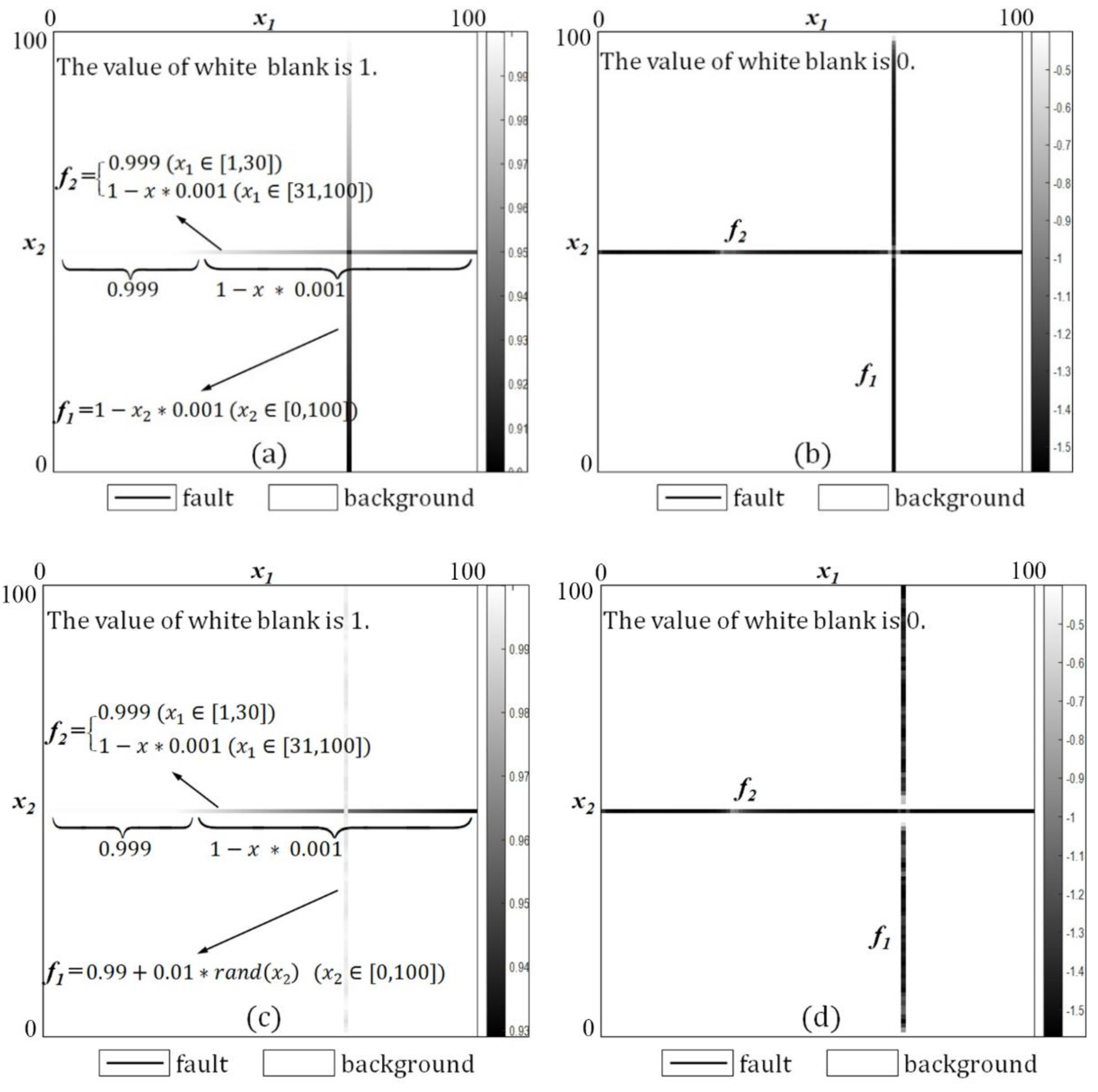
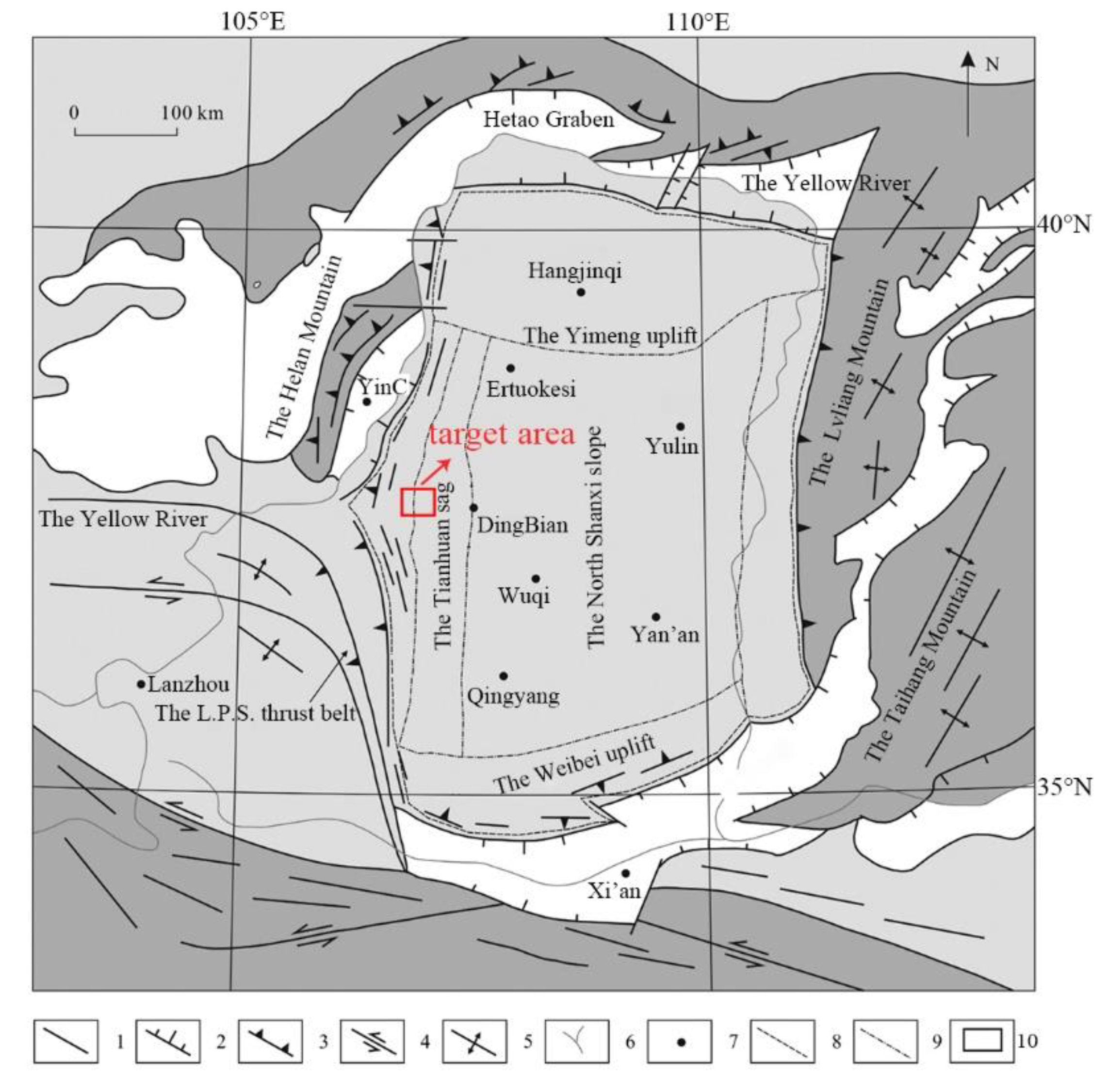
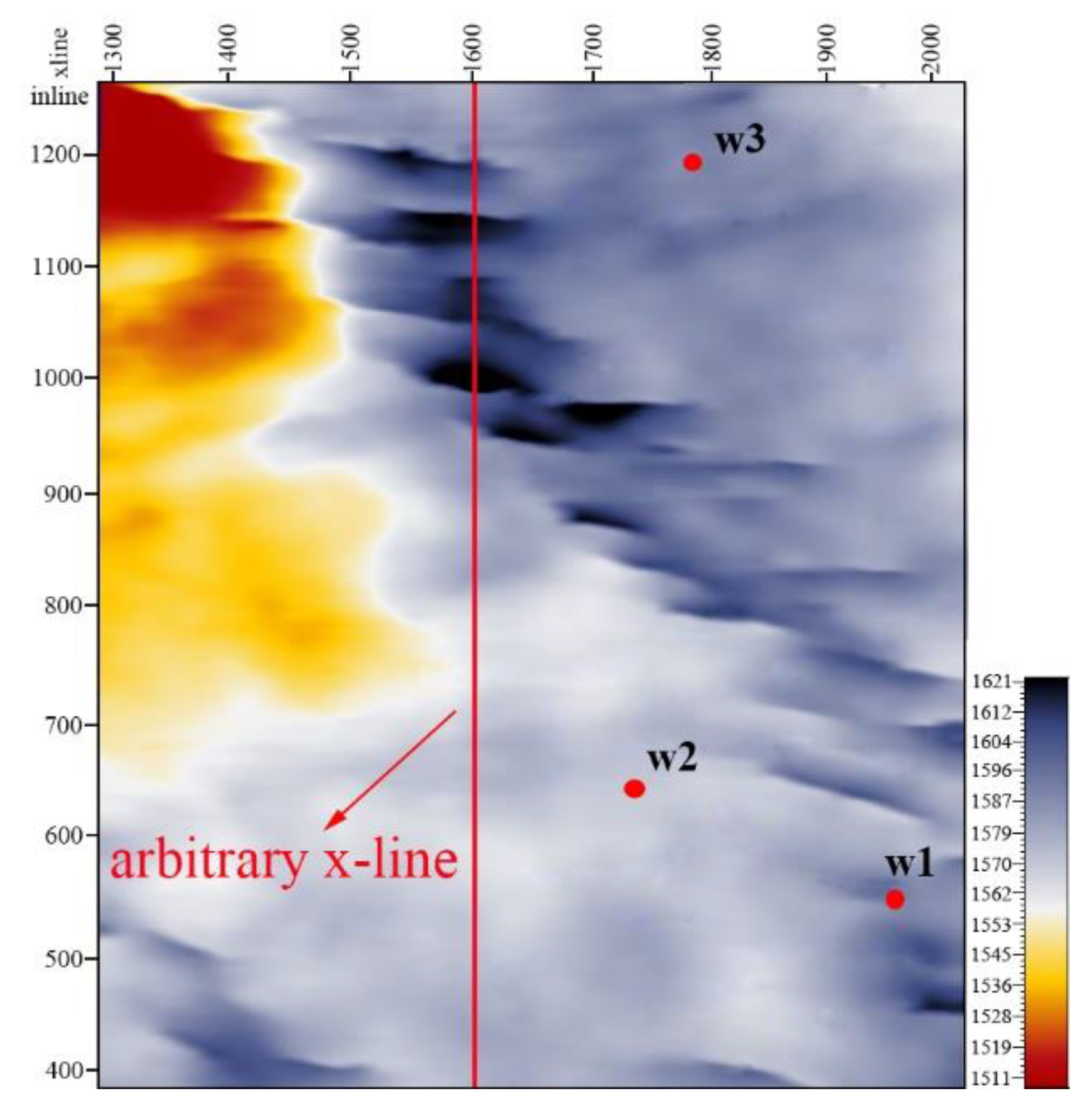

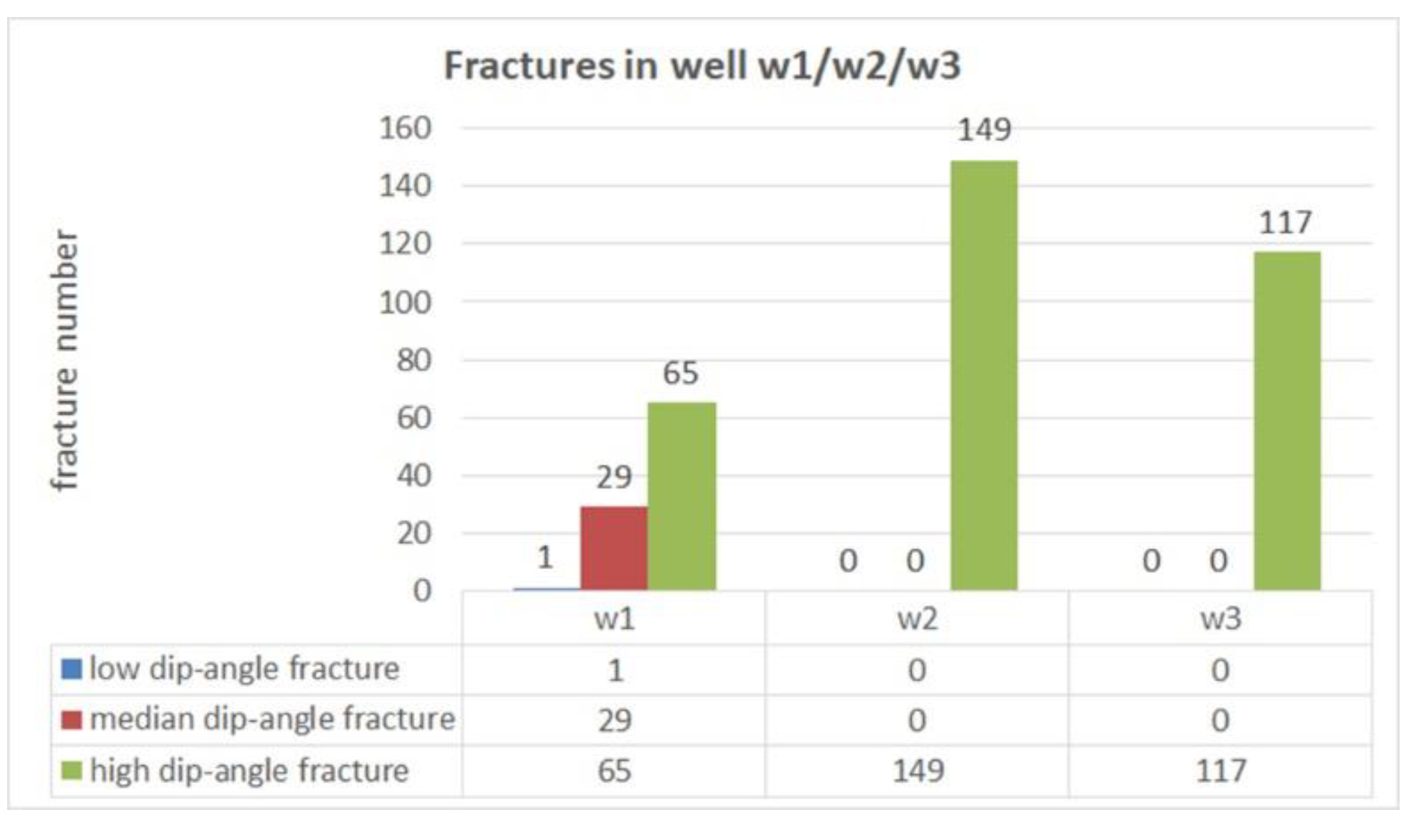
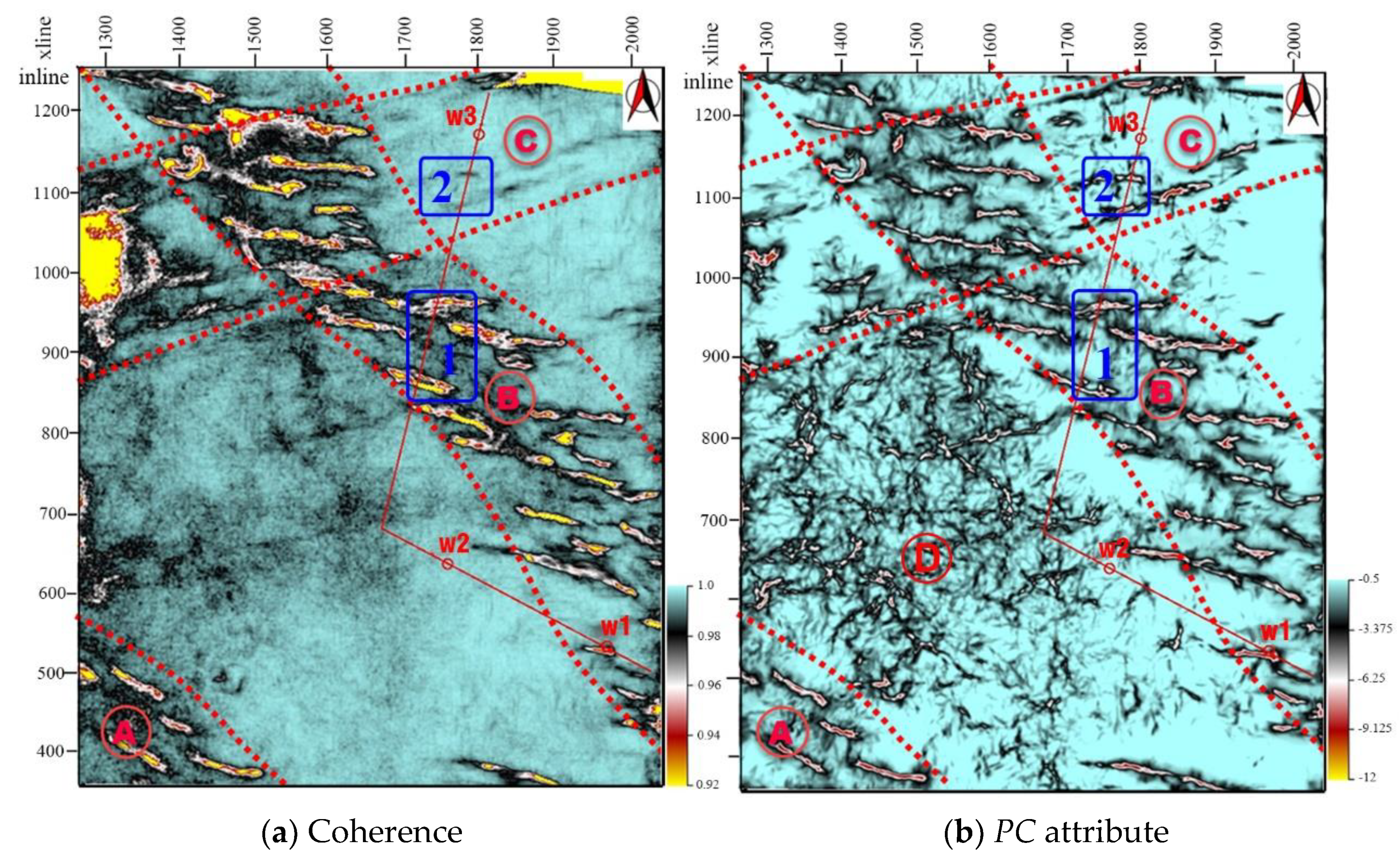
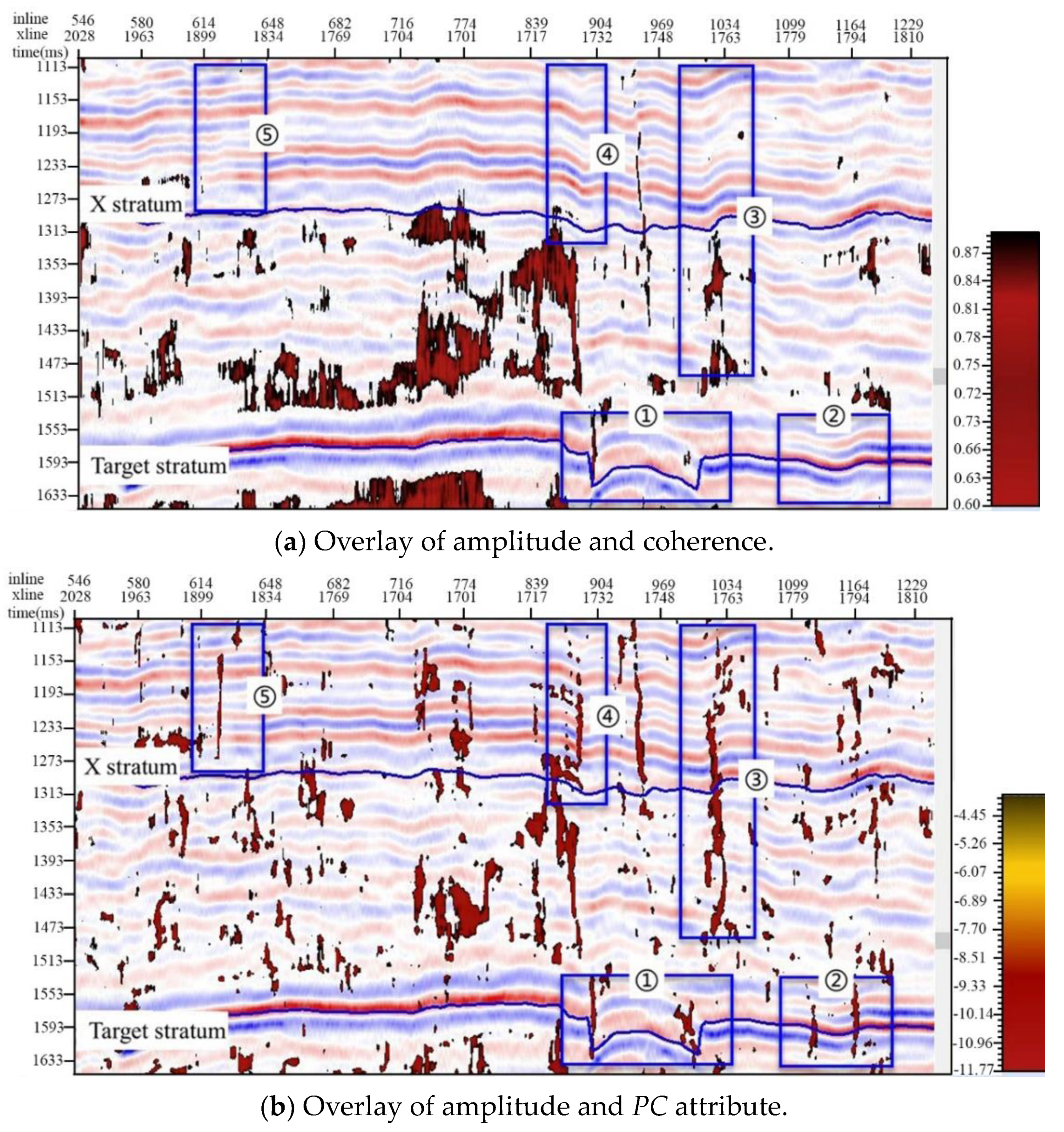
Publisher’s Note: MDPI stays neutral with regard to jurisdictional claims in published maps and institutional affiliations. |
© 2021 by the authors. Licensee MDPI, Basel, Switzerland. This article is an open access article distributed under the terms and conditions of the Creative Commons Attribution (CC BY) license (https://creativecommons.org/licenses/by/4.0/).
Share and Cite
Wang, E.; Zhang, J.; Yan, G.; Yang, Q.; Zhao, W.; Xie, C.; He, R. Concealed-Fault Detection in Low-Amplitude Tectonic Area—An Example of Tight Sandstone Reservoirs. Minerals 2021, 11, 1122. https://doi.org/10.3390/min11101122
Wang E, Zhang J, Yan G, Yang Q, Zhao W, Xie C, He R. Concealed-Fault Detection in Low-Amplitude Tectonic Area—An Example of Tight Sandstone Reservoirs. Minerals. 2021; 11(10):1122. https://doi.org/10.3390/min11101122
Chicago/Turabian StyleWang, Enli, Junduo Zhang, Guoliang Yan, Qing Yang, Wanjin Zhao, Chunhui Xie, and Run He. 2021. "Concealed-Fault Detection in Low-Amplitude Tectonic Area—An Example of Tight Sandstone Reservoirs" Minerals 11, no. 10: 1122. https://doi.org/10.3390/min11101122
APA StyleWang, E., Zhang, J., Yan, G., Yang, Q., Zhao, W., Xie, C., & He, R. (2021). Concealed-Fault Detection in Low-Amplitude Tectonic Area—An Example of Tight Sandstone Reservoirs. Minerals, 11(10), 1122. https://doi.org/10.3390/min11101122




